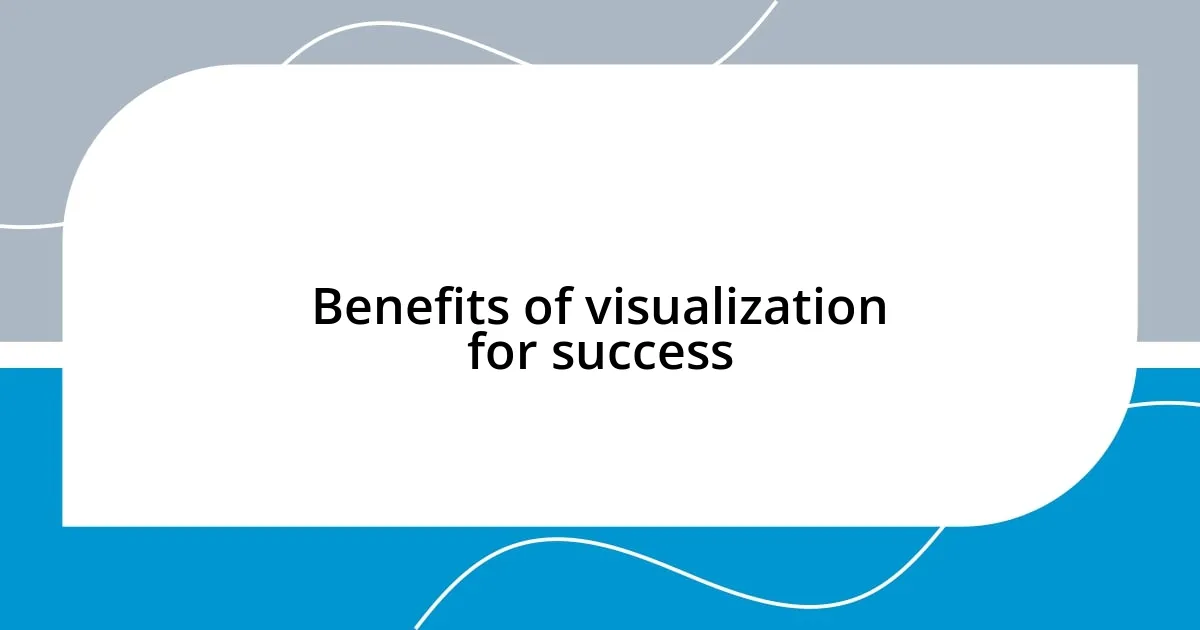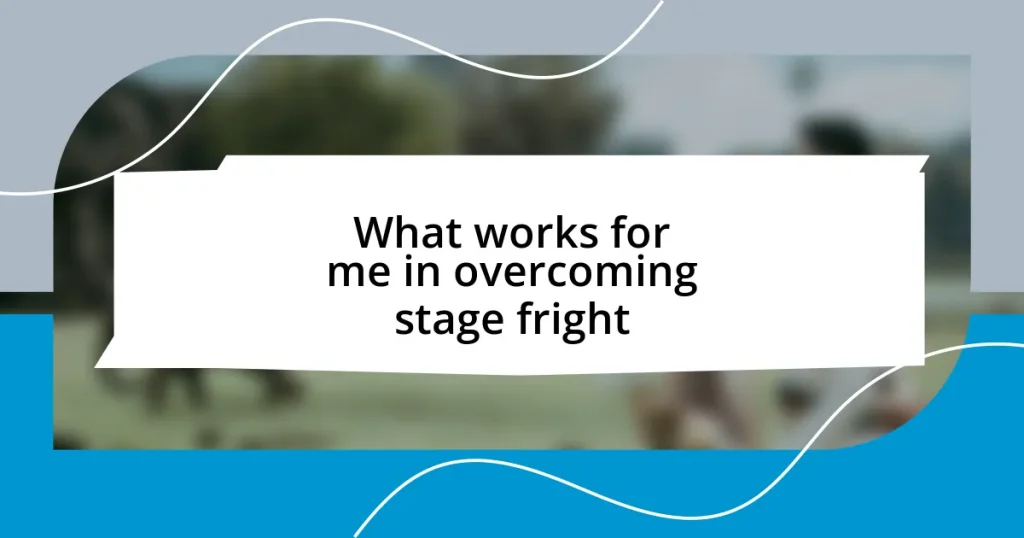Key takeaways:
- Visualization techniques enhance motivation and emotional connection, enabling individuals to imagine success vividly, which can create real feelings of achievement.
- Benefits of visualization include increased clarity in goal-setting, boosted confidence leading to improved performance, and enhanced resilience in overcoming challenges.
- To effectively implement visualization, it is essential to set clear goals, find a quiet space, engage the senses, and practice regularly.
- Measuring success through visualization involves tracking both the achievement of goals and the emotional effects of visualization practices on motivation and anxiety levels.

Understanding visualization techniques
Visualization techniques are powerful tools that use mental imagery to influence our thoughts, emotions, and ultimately, our actions. Imagine vividly picturing yourself achieving a goal—this can actually foster the motivation needed to make it happen. Have you ever found yourself so engrossed in a daydream about a successful presentation that you felt the adrenaline rush coursing through you, even though it was just a figment of your imagination?
When I first delved into visualization, it felt a bit peculiar. I vividly remember sitting in a quiet room, closing my eyes, and imagining my future success. It was like painting a picture in my mind, complete with colors and emotions. The more I practiced, the more real it became. This proves that the brain often doesn’t distinguish between real and imagined experiences. Isn’t that fascinating?
There’s also a distinct emotional element to visualization that I can’t overlook. When you visualize a positive outcome, your body can react as if it has already experienced it. I felt this firsthand before a major exam. I envisioned not just the results, but the sense of accomplishment and joy that would come with it. This emotional connection is what truly enhances the effectiveness of visualization techniques and allows you to manifest your goals.

Benefits of visualization for success
Visualization can bring a host of benefits that significantly contribute to achieving success. One of the most striking advantages I’ve experienced is the clarity it provides. By mentally rehearsing my goals, I find myself more focused and purposeful, as if the path ahead has been illuminated. For instance, when preparing for an important career shift, I vividly visualized each step I needed to take, which ultimately anchored me in the process. Have you ever felt overwhelmed by the sheer number of decisions you need to make? Visualization can help clarify your thoughts, narrowing down what truly serves your vision.
Moreover, the boost in confidence that comes from visualization is something I can’t emphasize enough. I recall a moment before a big presentation where I was riddled with anxiety. I took a few moments to visualize myself rocking the stage, connecting with the audience, and delivering my message with passion. The next thing I knew, I was striding onto that stage, and to my surprise, the nerves transformed into excitement. This mental practice not only calmed my nerves but also helped me perform at my best. Have you noticed how confidence breeds success?
It’s also fascinating to realize that visualization nurtures resilience. In times when I faced setbacks, visualizing my goals helped me refocus and persevere. For instance, after a failed attempt at a personal project, I spent time vividly picturing a future where I succeeded. This mental image fueled my determination, turning frustration into motivation. When we visualize success, we build a bridge to our dreams, making it easier to bounce back from challenges.
| Benefit | Description |
|---|---|
| Clarity | Helps focus on specific goals, making decisions easier. |
| Confidence | Boosts self-belief, transforming anxiety into excitement during performance. |
| Resilience | Encourages persistence in the face of setbacks, maintaining motivation. |

Steps to implement visualization
To incorporate visualization techniques effectively, start with a dedicated practice session; I typically find a quiet space where I can focus entirely. During this time, I close my eyes and begin to breathe deeply, allowing my mind to tune into the specific goal I want to visualize. I like to think about the details—the sights, sounds, and emotions associated with achieving that goal. This immersive practice often brings clarity and purpose to my intentions.
Here are some steps to help implement visualization in your routine:
- Set clear goals: Define what you want to achieve with specific, measurable objectives.
- Find a quiet space: Choose a comfortable and peaceful environment to minimize distractions.
- Use relaxation techniques: Take a few deep breaths or practice mindfulness to center yourself.
- Visualize the process: Picture not just the end result but the steps you need to take to get there.
- Engage your senses: Imagine the smells, sounds, and feelings involved in achieving your goal to make it more vivid.
- Regularly practice: Try to incorporate visualization into your daily routine, even if it’s just for a few minutes each day.
I often find that sharing my visualizations with a trusted friend or mentor helps solidify my intentions. When I expressed my vision for a recent project to a close colleague, it transformed my mental image into a tangible goal. Seeing their enthusiasm reflected back at me enhanced my motivation and commitment. It’s remarkable how verbalizing your aspirations can make them feel more achievable!

Techniques for effective visualization
When it comes to effective visualization, I’ve found that incorporating a routine is key. For me, starting each day with a few minutes of visualization sets a powerful tone. Just last week, I spent five minutes imagining how I wanted my day to unfold—a productive meeting, a fruitful conversation with a friend, and even some time for self-care. Isn’t it amazing how envisioning these moments can create an expectation in my mind? It’s like planting seeds that eventually blossom throughout the day.
Another technique that has made a difference is creating a vision board. I remember crafting mine; I filled it with images that represented my dreams and aspirations. Every time I walked by it, I felt a surge of motivation. Visual reminders keep my goals at the forefront of my mind, making the journey feel much more tangible. Do you have a visual representation of your aspirations? If not, I urge you to try this method; it’s a compelling way to align your daily actions with your larger vision.
Lastly, I find that including affirmations during my visualization enhances its effectiveness. Affirmations are positive statements that reinforce my beliefs about myself and my goals. For instance, as I visualize success in my career, I’ll repeat phrases like “I am capable” or “I am deserving of success.” This adds a layer of conviction to my mental imagery, creating a sense of empowerment. Have you ever experienced the powerful shift that comes from affirming your worth? It’s no wonder this technique has become an integral part of my visualization practice!

Overcoming challenges with visualization
Visualization can be a potent tool for overcoming challenges. I remember a time when I faced a major project deadline that felt overwhelming. Instead of succumbing to stress, I visualized myself breaking the work into manageable steps, picturing each stage completed successfully. This mental rehearsal changed my perspective and transformed an intimidating task into a series of achievable goals.
Sometimes, we face inner doubts that can stall our progress. I have encountered moments when I doubted my abilities, feeling like an imposter at work. During these times, I visualize my role clearly, recalling specific instances where I succeeded in similar situations. This practice not only boosts my confidence but also reinforces the belief that I am capable of overcoming any hurdle in my path. Have you ever felt that inner critic whispering doubt? Visualizing your past successes can serve as a powerful counter to that negative voice.
An unexpected benefit of visualization is its ability to foster resilience. Recently, I had an unexpected setback in a personal goal I was pursuing. Instead of letting it derail me, I took time to visualize how I could bounce back. I imagined myself regrouping, reassessing my approach, and tackling the challenge anew. This imagining wasn’t just comforting; it ignited a fire within me to persist, reminding me that setbacks are often just setups for comebacks. How do you react when life throws you a curveball? Embracing visualization can help turn those moments of uncertainty into stepping stones toward success.

Real-life success stories
There’s something truly inspiring about hearing how others have harnessed visualization for their success. One of my friends, a budding entrepreneur, shared her journey of launching her first business. She spent countless nights visualizing her ideal workspace, imagining how it would feel to walk into a space filled with her ideas and hard work. When she finally opened her doors, I could see the spark in her eyes—it was like she had stepped right out of her own dream.
Another story that resonates with me is about a renowned athlete I stumbled upon during an interview. This athlete talked about his pre-competition rituals, which included intense visualization sessions. He would envision every detail of the race, from the sound of the starting gun to the thrill of crossing the finish line. The emotional energy he described was contagious; it gave him the focus and confidence to perform at his best. Have you ever thought about how mental rehearsal could change your approach to challenges?
Lastly, I recall a transformational experience I had while preparing for a significant presentation. I took the time to close my eyes and visualize not only delivering my speech but also receiving a warm reaction from the audience. As I imagined the smiles and applause that followed, a sense of calm washed over me. When the day finally arrived, those mental images became my reality. Isn’t it fascinating how your mind, when aligned with a clear vision, can lead you to such rewarding outcomes?

Measuring success with visualization techniques
Measuring success with visualization techniques is more than just tracking outcomes; it’s about reflecting on the journey. In my experience, I use visualization to set clear benchmarks for what success looks like. For instance, when I embarked on a new fitness routine, I created mental images of my progress—seeing myself reaching specific milestones, like lifting weights or running longer distances. These vivid pictures helped me fine-tune my goals, making the achievements feel tangible before they even unfolded.
One of the most enlightening moments for me was when I started visualizing not just my end goals, but also the daily habits that would lead me there. I recall sitting quietly and picturing myself waking up early, preparing healthy meals, and feeling energized throughout the day. This simple mental practice helped me measure my success day by day, as each positive choice became a part of my visualized narrative. Do you think about the small, everyday victories that contribute to your larger goals? I found that celebrating these moments transformed my perspective on success from being an end-point to an ongoing journey.
In discussing measurement, I also believe in tracking how visualization influences my emotional state. I often take a moment to reflect after each visualization exercise, assessing how it affects my motivation and anxiety levels. For instance, prior to a big meeting, I visualize myself speaking confidently and engaging the team. Afterward, I notice that I approach the actual meeting with a reduced level of stress and a heightened sense of readiness. How do you process your emotional responses to your visualizations? Through this, I’ve learned that success isn’t just about the results; it’s also about the mindset you cultivate along the way.
















